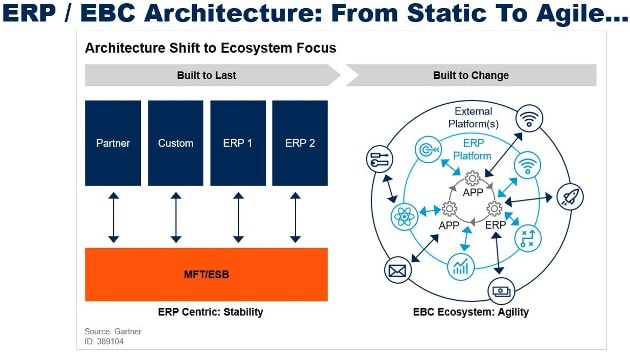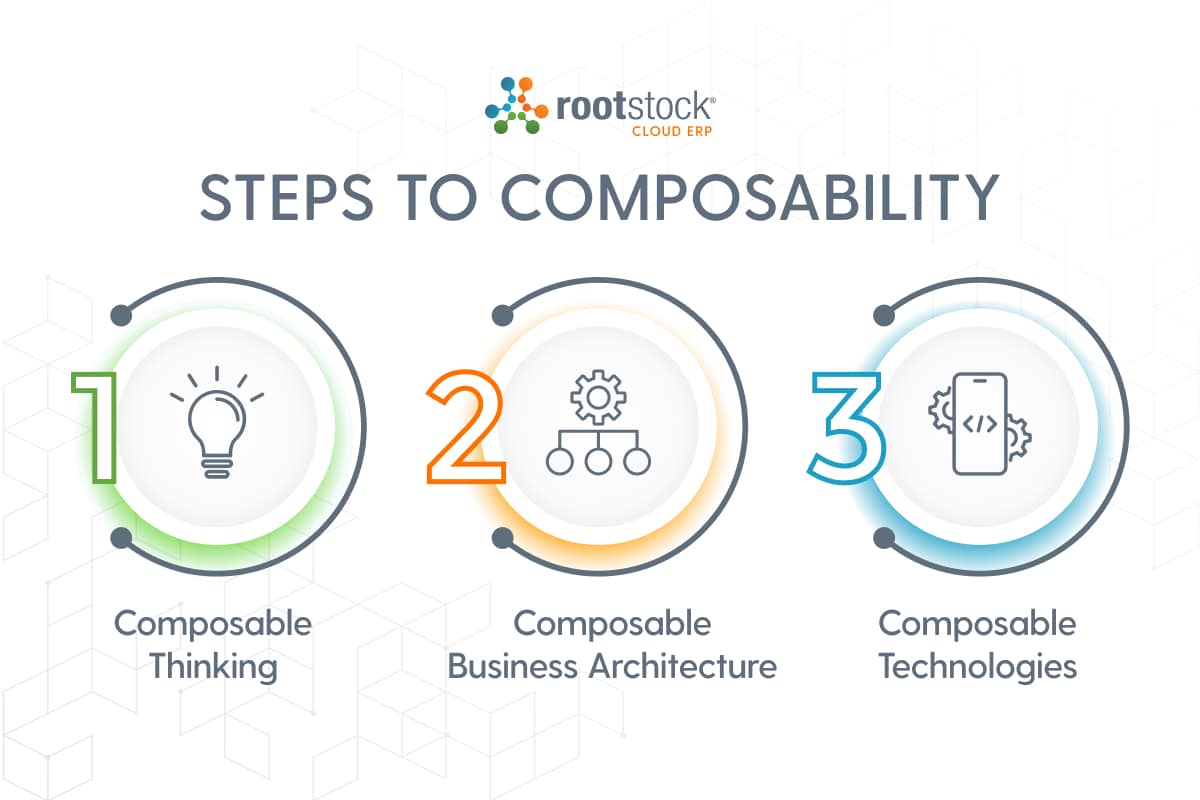Topics of interest
Enterprise Resource Planning. It’s a term that has been in the manufacturing industry for more than 25 years, and it has become a key component of either competitive advantage or organizational strain. Enterprises that have remained anchored to decades-old, monolithic technologies are feeling the pain. However, ones that have adopted modern, cloud-based ERP are today realizing the benefits of innovation, flexibility, and speed across their manufacturing operations.
According to leading research firm Gartner, companies are redefining ERP to create business capabilities that enable and empower teams at the most granular levels. Instead of pushing you to leap to another new technology, however, composable ERP is a new approach to enabling your operations using elements of the ERP you already have.
And it’s on the radar of manufacturers. A recent Gartner study found that nearly three in four executives want to accelerate digital strategies to deal with constant disruption. To achieve such resilience and agility, the firm recommends a composable IT strategy.
But what is a composable ERP, and what does it look like? And, how can manufacturers benefit from a composable ERP strategy? Let’s explore.
What is Composable ERP?
According to Gartner, Composable ERP is, “an adaptive technology strategy that enables the foundational administrative and operational capabilities for an enterprise to keep pace with change”. In other words, composable ERP enables manufacturers to create, modify, and extend their ERP system to meet— with speed and agility— whatever dynamic needs they might have. Composable ERP involves creating a network of applications, data, and solution providers which work seamlessly together to fit any business need.
Composable ERP is not a new type of ERP, but a strategy to give you the power to change your ERP as your business needs change. That is the crux of composable: instead of a static, monolithic system, it’s a flexible, agile solution built for the needs of today’s changing business. Gartner explains this shift to “ERP’s Fourth Era” as going from “built to last” and moving to “built to change.”

How Can Composable ERP Help?
Composable ERP can change as your business changes. When you identify new opportunities, you often need new capabilities. In this new model, you compose what you need when you need it.
Here are a few examples of where composable ERP can help you quickly build custom apps for changing needs:
- Take advantage of today’s APIs, cloud connectors, third-party apps, and modern enterprise technology platforms seamlessly so you can benefit from other solutions you already use or quickly extend by bringing on new solutions.
- Democratize the power of ERP by enabling easy, low-code/no-code creation of applications for everyone inside and outside of operations, from Finance and HR to Sales and Marketing.
- Build new mobile experiences to empower workers across the factory floor, warehouses, or in the field.
- Quickly enable new dashboards for visibility into any area of interest and at any level.
Gartner has written extensively about composable ERP. The research firm refers to the output as “application experiences,” which are essentially custom apps you build on your ERP. But what is critical is the foundation on which you create these application experiences. It must be flexible, stable, and capable of supporting the hundreds or thousands of application experiences your business requires.
How to Deploy a Composable ERP Strategy
Manufacturers cannot just find a vendor and purchase composable ERP. Composable ERP is more of an approach and strategy versus an off-the-shelf solution. However, having the right ERP vendor on a flexible platform is required to support your composable ERP future. When developing a composable ERP strategy, there are four critical steps you should take.
1. Define Business Outcomes
Start by identifying the specific business capabilities you want as well as the measurable improvements you desire. What capabilities are missing in your current ERP or business platforms? What capabilities does the ERP system need to support your business plan? During this process, you should involve several stakeholders from your company, including an executive sponsor, a project leader, an IT expert, and representatives from different functional areas of your company.
See what questions you and your team need to discuss to determine what capabilities your ERP or business platform will need.
2. Find the Right ERP Software
Once you’ve identified the specific business capabilities that you’d like to have, and you’ve determined measurable improvements you want to see, you then want to develop a strategy around an ERP or business platform. You should evaluate several types of ERP software to help you best determine which ERP vendors have the right capabilities for your business needs.
Download our free Cloud ERP Evaluation Guide to help you determine which ERP vendor has the best capabilities in the areas that matter to your business.
3. Define integration, data, and user experience strategies
Consider the existing and needed tools, points of integration, and the users themselves to guide the creation of the eventual application experiences required to achieve your goals. Integration is where the choice of cloud platform plays a central role in your evaluation. For example, if your company already uses Salesforce CRM, you will want to look at cloud ERP solutions on the Salesforce cloud platform. Salesforce and Rootstock Software seamlessly integrate to give you a 360-degree view of your entire organization, your suppliers, and your customers.
4. Enhance Skills
Once you’ve implemented the right tools for your needs, it’s important to continuously evaluate how these systems are performing. Focus on evaluating the data, whether from ERP or other systems, needed to empower your workers and implement new changes that adapt to their needs.
Consider Rootstock for Composable ERP
Rootstock Cloud ERP was designed from the ground up to be a flexible manufacturing solution that drives agility across all operational areas. Being built on the Salesforce platform provides native integration with CRM, service, marketing, quote-to-cash, and other capabilities, both from Salesforce and its massive AppExchange. Rootstock Cloud ERP gives manufacturers a transformational platform to run everything from sales to customer service, engineering to production, supply chain to inventory.
Rootstock Cloud ERP also provides an ideal platform for an even more extensible composable ERP. Our wide range of software partners provides capabilities for accounting, quality, compliance, field service, and more. But, even more so, the low-code/no-code capabilities of Rootstock and the Salesforce Platform enable you to quickly, easily, and efficiently build the application experiences you need to respond to your business’ next unforeseen challenge.
To learn more about the composable ERP benefits of Rootstock Cloud ERP, watch our four-minute Cloud ERP demo or request a personalized demonstration today.







